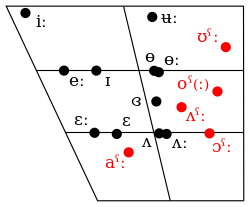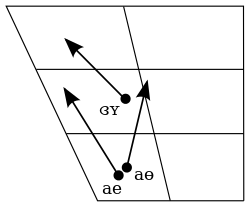Chemnitz dialect
Chemnitz dialect is a distinct German dialect of the city of Chemnitz and an urban variety of Vorerzgebirgisch, a variant of Upper Saxon German.[1]
| Chemnitz dialect | |
|---|---|
| Native to | Germany |
| Region | Chemnitz |
| Language codes | |
| ISO 639-3 | – |
| Glottolog | None |
Phonology
Consonants
| Labial | Dental | Postalveolar | Dorsal | Glottal | ||
|---|---|---|---|---|---|---|
| Nasal | m | n | ŋ | |||
| Plosive | fortis | kʰ | ||||
| lenis | p | t | k | |||
| Fricative | f | s | ʃ | χ | h | |
| Approximant | ʋ | j | ||||
| Liquid | l | ʁ | ||||
- /m, p/ are bilabial, whereas /f, ʋ/ are labiodental.[2]
- /n, t, l, s/ are dental [n̪, t̪, l̪, s̪].[1]
- /t/ is alveolar [t͇] after /ʃ/.[3]
- /ŋ, kʰ, k/ are velar, /χ, ʁ/ are uvular, and /j/ is palatal. /χ-ʁ/ do not constitute a voiceless-voiced pair.[2]
- /p, t, k, f, s, ʃ, χ/ may be voiced between sonorants.[4]
- When a stop or fricative precedes, the sequences /əm, ən, əŋ, əl/ can be realized as syllabic consonants [m̩, n̩, ŋ̍, l̩]. The nasals appear depending on the place of articulation of the preceding consonant, so that it can be bilabial [m̩], dental [n̩], velar [ŋ̍] or uvular [ɴ̩].[3]
- When another nasal precedes a syllabic nasal, such sequence is realized as a single consonant of variable length.[3]
- Non-phonemic glottal stop [ʔ] is inserted in two cases:
Vowels

Monophthongs of the Chemnitz dialect, from Khan & Weise (2013:236–237). Red vowels are pharyngealized.
|
|
| |||||||||||||||||||||||||||||||||||||||||||||||||||||||||||||||
- The pharyngealized vowels correspond to the sequences of vowel + /r/ in the standard language.[8]
- The non-native vowels are occasionally used in cognates of some Standard German words, such as brüder [ˈpʁyːtoˤ] ('brothers'). In other cases, they are pronounced the same as /ɪ, iː, ɛ, eː/.[9]
- Unstressed short oral monophthongs may fall together as [ə].[7]
- /ʊˤː, oˤː, ʌˤː, ɔˤː, aˤː/ are often diphthongal [ʊːɒ̯ˤ, oːɒ̯ˤ, ɪːɒ̯ˤ, ɔːɒ̯ˤ, ɛːɒ̯ˤ] in careful speech. Monophthongal realizations are optionally shortened in certain positions.[10]
- /oˤ/ corresponds to Standard German [ɐ].[8]
- Monophthongs are somewhat retracted when they precede dorsals, except /j/. The retraction is strongest before /χ, ʁ/. To a certain extent, this is also true of monophthongs that follow dorsal consonants.[9]
- Monophthongs are allophonically pharyngealized if a vowel in the following syllable is pharyngealized.[9]
- The phonetic quality of the monophthongs is as follows:
- /iː, ʉː, ɵ, ɵː, ʊˤː/ are close to the canonical values of the corresponding IPA symbols [iː, ʉː, ɵ, ɵː, ʊˤː].[10]
- /ɪ/ is close-mid [ɪ̞].[7]
- /eː, ɛ, ɛː, oˤ, oˤː, ɔˤː/ are more central than the canonical values of the corresponding IPA symbols: [ëː, ɛ̈, ɛ̈ː, öˤ, öˤː, ɔ̈ˤː].[10]
- /ɞ/ is mid [ɞ̝].[7]
- /ʌˤː/ is mid near-back [ʌ̝̈ˤː].[8]
- /ʌ, ʌː/ are central [ɜ, ɜː].[7]
- /aˤː/ is near-open near-front [ä̝ˤː].[8]

| Ending point | ||
|---|---|---|
| unrounded | rounded | |
| Mid | ɞʏ | |
| Open | ae | aɵ |
- The starting point of /ɞʏ/ is higher and more front than the canonical value of the corresponding IPA symbol ([ɞ̝˖]).[8]
- The starting points of /ae/ and /aɵ/ are higher and more central than the canonical value of the corresponding IPA symbol ([ä̝]).[8]
- The ending points of Chemnitz German diphthongs are close to the canonical values of the corresponding IPA symbols ([ʏ, e, ɵ]).[8]
Sample
The sample text is a reading of the first sentence of The North Wind and the Sun.[11]
Broad phonetic transcription
[ˈeːnəs ˈtʌːχəs hʌmʃ toˤ ˈnoˤːtʋɪnt ɵnt tə ˈsɞnə kəˈtsʌŋt | ʋaˤː fɞn ˈpeːtn̩ tɛn nʉː toˤ ˈʃtaˤːkʁə ɪs | ɛls ə ˈʋʌntʁoˤ mɪt nəm ˈʋɔˤːmən ˈmʌntl̩ ʌn | foˤˈpeːkʰʌːm][11]
Orthographic version (standard German)
Eines Tages haben sich der Nordwind und die Sonne gezankt, wer von den beiden denn nun der Stärkere ist, als ein Wanderer mit einem warmen Mantel an, vorbeikam.[11]
gollark: I was looking at the WHATWG's documentation on application/x-www-form-urlencoded and it says this:> The application/x-www-form-urlencoded format is in many ways an aberrant monstrosity, the result of many years of implementation accidents and compromises leading to a set of requirements necessary for interoperability, but in no way representing good design practices.
gollark: I feel like they could probably just, if it's for array literals, get away with limiting it to 16 or so with no major issues.
gollark: It's allegedly to make neater bytecode.
gollark: This code is a TOTAL apiohazard.
gollark: Maybe some sort of abstract interface for them which is implemented by the class.
References
- Khan & Weise (2013), p. 231.
- Khan & Weise (2013), pp. 231–232.
- Khan & Weise (2013), p. 235.
- Khan & Weise (2013), pp. 232–233.
- Khan & Weise (2013), p. 232.
- Khan & Weise (2013), p. 234.
- Khan & Weise (2013), p. 236.
- Khan & Weise (2013), p. 237.
- Khan & Weise (2013), p. 238.
- Khan & Weise (2013), pp. 236–237.
- Khan & Weise (2013), p. 239.
Bibliography
- Khan, Sameer ud Dowla; Weise, Constanze (2013), "Upper Saxon (Chemnitz dialect)" (PDF), Journal of the International Phonetic Association, 43 (2): 231–241, doi:10.1017/S0025100313000145
This article is issued from Wikipedia. The text is licensed under Creative Commons - Attribution - Sharealike. Additional terms may apply for the media files.